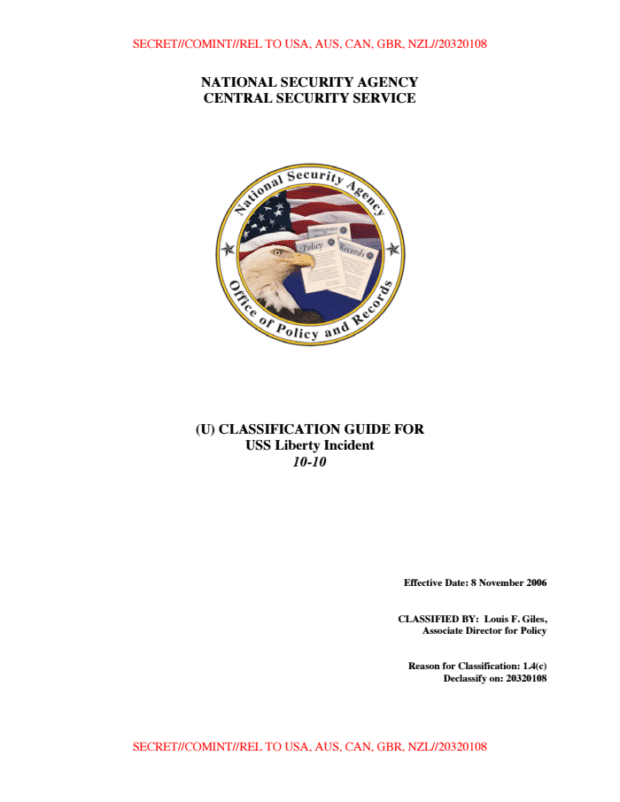Historical
See other Historical Articles
Title: Fifty Years Later, NSA Keeps Details of Israel’s USS Liberty Attack Secret
Source:
Lew Rockwell/The Intercept
URL Source: https://www.lewrockwell.com/2020/06 ... els-uss-liberty-attack-secret/
Published: Jun 9, 2020
Author: Miriam Pensack
Post Date: 2020-06-09 04:35:49 by Deckard
Keywords: None
Views: 375
ON JUNE 8, 1967, an Israeli torpedo tore through the side of the unarmed American naval vessel USS Liberty, approximately a dozen miles off the Sinai coast. The ship, whose crew was under command of the National Security Agency, was intercepting communications at the height of the Six-Day War when it came under direct Israeli aerial and naval assault. Reverberations from the torpedo blast sent crewman Ernie Gallo flying across the radio research room where he was stationed. Gallo, a communications technician aboard the Liberty, found himself and his fellow shipmates in the midst of an attack that would leave 34 Americans dead and 171 wounded. This week marks the 50th anniversary of the assault on the USS Liberty, and though it was among the worst attacks in history against a noncombatant U.S. naval vessel, the tragedy remains shrouded in secrecy. The question of if and when Israeli forces became aware they were killing Americans has proved a point of particular contention in the on-again, off-again public debate that has simmered over the last half a century. The Navy Court of Inquiry’s investigation proceedings following the incident were held in closed sessions, and the survivors who had been on board received gag orders forbidding them to ever talk about what they endured that day. Now, half a century later, The Intercept is publishing two classified documents provided in the cache of files leaked by NSA whistleblower Edward Snowden related to the attack and its aftermath. They reveal previously unknown involvement by Government Communications Headquarters, the U.K. signals intelligence agency; internal NSA communications that seem to bolster a signals intelligence analyst’s account of the incident, which framed it as an accident; as well as a Hebrew transliteration system unique to the NSA that was in use at least as recently as 2006. The first document, a formerly unreleased NSA classification guide, details which elements of the incident the agency still regarded as secret as of 2006. The second lists a series of unauthorized signals intelligence disclosures that “have had a detrimental effect on our ability to produce intelligence against terrorist targets and other targets of national concern.” Remarkably, information relevant to the attack on the Liberty falls within this highly secret category. Though neither document reveals conclusive information about the causes of the assault, both highlight that at the time of their publication — approximately four decades after the incident — the NSA was determined to keep even seemingly minor details about the attack classified. The agency declined to comment for this article. The classification guide, dated November 8, 2006, indicates previously unknown GCHQ involvement in the ship’s intelligence gathering. The specifics of this involvement remain classified, and it is therefore unclear if involvement was of a material nature on board the ship or through other means. GCHQ declined to comment. The guide also reveals NSA’s own classified Hebrew transliteration system, the existence of which underlines that the agency has historically counted Israel as an intelligence target even as the nation acted as a key partner in signals collection. This inherent tension in the U.S.-Israeli relationship was also manifest on the Liberty, where the Hebrew translators brought aboard the ship were referred to as “special Arabic” linguists, according to journalist James Bamford, in order to conceal their surveillance of Israeli communications.
Post Comment Private Reply Ignore Thread
[Home] [Headlines] [Latest Articles] [Latest Comments] [Post] [Mail] [Sign-in] [Setup] [Help] [Register]

